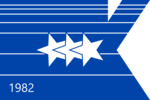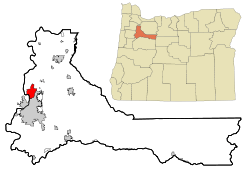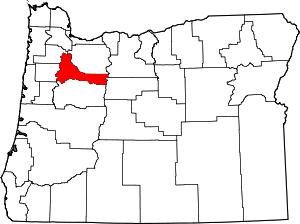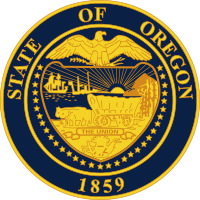Keizer, Oregon
Keizer /ˈkaɪzər/ is a city located in Marion County, Oregon, United States, along the 45th parallel. As of the 2010 United States Census, its population was 36,478. It lies in the Willamette Valley and is part of the Salem Metropolitan Statistical Area. It was named after brothers Thomas Dove (T. D.) and John Brooks (J. B.) Keizur, two pioneers who arrived in the Wagon Train of 1843, and later filed donation land claims.
Keizer | |
|---|---|
| Keizer, Oregon | |
Keizer Station shopping center in Keizer | |
 Flag | |
 Location in Marion County, Oregon | |
| Coordinates: 45°0′2″N 123°1′19″W[1] | |
| Country | United States |
| State | Oregon |
| County | Marion |
| Incorporated | 1982 |
| Government | |
| • Mayor | Cathy Clark |
| Area | |
| • Total | 7.26 sq mi (18.81 km2) |
| • Land | 7.15 sq mi (18.53 km2) |
| • Water | 0.11 sq mi (0.28 km2) |
| Elevation | 132 ft (40 m) |
| Population | |
| • Total | 36,478 |
| • Estimate (2019)[4] | 39,713 |
| • Density | 5,551.16/sq mi (2,143.31/km2) |
| Time zone | UTC-8 (Pacific) |
| • Summer (DST) | UTC-7 (Pacific) |
| ZIP codes | 97303, 97307 |
| Area code(s) | 503 |
| FIPS code | 41-38500[3] |
| GNIS feature ID | 1163084[5] |
| Website | City of Keizer |
History
The original settlement was at Keizer Bottom, near the banks of the Willamette River. The community was named after Thomas Dove Keizur, one of its first settlers. Somewhere in the translation of donation land claim records, his name was misspelled.[6][7] The settlement suffered in the flood of 1861, and the inhabitants rebuilt their homes on higher ground. Further floods in 1943, 1945, 1946 and 1948 hampered the growth of the community, and it was not until dams were built in the 1950s to regulate the flow of the Willamette that Keizer began to flourish.
The City of Salem tried to annex the growing community adjacent to its city limits many times.[8] Beginning in 1964, a number of Keizer residents tried to convince the people of Keizer that it would be cheaper and better to form their own city. It was not until November 2, 1982, that, with the support of the nearby unincorporated community of Clear Lake, residents voted to make Keizer a city.[8]
Keizer Bottom is now the site of Keizer Rapids Park, a public park whose attractions include a dog park, playground, boat-in camping, nature trails, a disc golf course, and sport courts.
Geography
According to the United States Census Bureau, the city has a total area of 7.21 square miles (18.67 km2), of which 7.09 square miles (18.36 km2) is land and 0.12 square miles (0.31 km2) is water.[9]
Demographics
| Historical population | |||
|---|---|---|---|
| Census | Pop. | %± | |
| 1990 | 21,884 | — | |
| 2000 | 32,203 | 47.2% | |
| 2010 | 36,478 | 13.3% | |
| Est. 2019 | 39,713 | [4] | 8.9% |
| Sources:[3][10] | |||
2010 census
As of the census of 2010, there were 36,478 people, 13,703 households, and 9,498 families living in the city. The population density was 5,145.0 inhabitants per square mile (1,986.5/km2). There were 14,445 housing units at an average density of 2,037.4 per square mile (786.6/km2). The racial makeup of the city was 82.5% White, 0.8% African American, 1.3% Native American, 1.6% Asian, 0.6% Pacific Islander, 9.0% from other races, and 4.1% from two or more races. Hispanic or Latino of any race were 18.3% of the population.[3]
There were 13,703 households of which 36.9% had children under the age of 18 living with them, 51.0% were married couples living together, 13.3% had a female householder with no husband present, 5.0% had a male householder with no wife present, and 30.7% were non-families. 24.2% of all households were made up of individuals and 10.3% had someone living alone who was 65 years of age or older. The average household size was 2.64 and the average family size was 3.13.[3]
The median age in the city was 35.7 years. 27.3% of residents were under the age of 18; 8.1% were between the ages of 18 and 24; 26.6% were from 25 to 44; 24.7% were from 45 to 64; and 13.3% were 65 years of age or older. The gender makeup of the city was 48.0% male and 52.0% female.[3]
2000 census
As of the census of 2000, there were 32,203 people, 12,110 households, and 8,646 families living in the city. The population density was 4,455.7 people per square mile (1,719.7/km2). There were 12,774 housing units at an average density of 1,767.4 per square mile (682.2/km2). The racial makeup of the city was 85.52% White, 0.75% African American, 1.38% Native American, 1.49% Asian, 0.20% Pacific Islander, 7.22% from other races, and 3.44% from two or more races. Hispanic or Latino of any race were 12.27% of the population.[3]
There were 12,110 households out of which 35.6% had children under the age of 18 living with them, 55.8% were married couples living together, 11.2% had a female householder with no husband present, and 28.6% were non-families. 22.4% of all households were made up of individuals and 8.4% had someone living alone who was 65 years of age or older. The average household size was 2.64 and the average family size was 3.07. In the city, the population was 27.7% under the age of 18, 8.2% from 18 to 24, 30.1% from 25 to 44, 21.9% from 45 to 64, and 12.2% who were 65 years of age or older. The median age was 34 years. For every 100 females, there were 94.3 males. For every 100 females age 18 and over, there were 91.2 males The median income for a household in the city was $45,052, and the median income for a family was $49,977. Males had a median income of $37,138 versus $27,032 for females. The per capita income for the city was $20,119. About 6.2% of families and 9.3% of the population were below the poverty line, including 11.7% of those under age 18 and 7.6% of those age 65 or over.[3]
Arts and culture
Annual cultural events
The annual KeizerFEST, formally known as the Iris Festival, takes place in May and showcases Keizer's iris-growing industry.[11] The festival was founded by Schreiner's Iris Gardens, one of the country's largest retail iris growers, and has been facilitated by the Keizer Chamber of Commerce since 1987.[12][13] Events include a carnival, a beer garden, craft and food vendors, a 5k walk/run, a vintage car show, and a parade.[11]
Every year from the beginning of December until the day after Christmas the Gubser school neighborhood hosts the "Keizer Miracle of Christmas Lighting Display." Many of the neighborhood's residents decide to put up Christmas lights along with other various holiday themed displays. Up to 20,000 vehicles visit the approximately 3.5-mile (5.6 km) route each year. Along the route visitors are able to donate canned foods and non-perishable items. In 2007 19,000 pounds (8,600 kg) of food were collected for the Marion Polk Food Share and $17,100 was received in cash.
Museums and other points of interest
The Keizer Heritage Museum is inside the Keizer Heritage Community Center, which was formerly the Keizer School.[14] The school, built in 1916, has been completely restored and is the only public historic building in Keizer.[15] Other tenants of the building include the Keizer Community Library, the Keizer Art Association and gallery, and the Keizer Chamber of Commerce.[15]
Sports
The Salem-Keizer Volcanoes, a single A short season minor league baseball team in the Northwest League have their stadium, Volcanoes Stadium, in Keizer. In addition to minor league baseball, Volcanoes Stadium has hosted the OSAA baseball championship and a Civil War baseball game between the University of Oregon Ducks and Oregon State University Beavers.
Keizer has been a long supporter of its lone high school's sports teams, the McNary Celtics. The school has won multiple state titles in recent years, the last coming in 2009 when the baseball team won the state championship in Volcanoes Stadium.[16]
Education
Keizer is part of the Salem-Keizer School District and has one high school: McNary, two middle schools: Claggett Creek and Whiteaker, and seven elementary schools: Clear Lake, Cummings, Forest Ridge, Gubser, Keizer, Kennedy and Weddle.[17]
The first schoolhouse in the Keizer area was built in 1878, and its first teacher was Nina McNary, older sister of U.S. Senator Charles L. McNary.[18] The first school was torn down in 1915 and replaced in 1916 with the building that now serves as the Keizer Heritage Community Center.[18] By the 1980s, the 1916 Keizer Elementary School was judged unsafe and a new school was built in 1987.[18] Cummings School was built in 1953 to serve the area's growing population.[18] In 1955, Keizer School District #88 and Salem School District # 24CJ merged to form the Salem Keizer School District.[18]
Media
- Keizertimes — weekly newspaper
Notable people
- Grayson Boucher (born 1984) – streetball player for the AND1 Mixtape Tour who is better known by his nickname "The Professor"
- Deen Castronovo (born 1965) – drummer for Ozzy Osbourne and Journey[19][20]
- Daniel R. Hokanson – lieutenant general in the U.S. Army[21]
- Charles L. McNary – U.S. Senator
- Michael Uppendahl – television director
- Austin Bibens-Dirkx - MLB Pitcher
References
- "US Gazetteer files: 2010, 2000, and 1990". United States Census Bureau. February 12, 2011. Retrieved April 23, 2011.
- "2019 U.S. Gazetteer Files". United States Census Bureau. Retrieved July 28, 2020.
- "U.S. Census website". United States Census Bureau. Retrieved December 21, 2012.
- "Population and Housing Unit Estimates". United States Census Bureau. May 24, 2020. Retrieved May 27, 2020.
- "US Board on Geographic Names". United States Geological Survey. October 25, 2007. Retrieved January 31, 2008.
- Keizur Barrett, Daisy; Ginger Powers (1983). The Keizer Story (Keizur). Linn County Historical Museum.
- "Keizer's First Families, Part 1". Keizertimes.com. Retrieved June 21, 2011.
- "A Brief History of Keizer". Keisertimes.com. Retrieved June 21, 2011.
- "US Gazetteer files 2010". United States Census Bureau. Archived from the original on July 2, 2012. Retrieved December 21, 2012.
- "Oregon: Population and Housing Unit Counts" (PDF). U.S. Census Bureau. Retrieved November 22, 2013.
- "Keizer Iris Festival". Retrieved February 20, 2010.
- "In Full Bloom". Travel Oregon (Oregon Tourism Commission). Archived from the original on March 25, 2010. Retrieved February 20, 2010.
- "Keizer Chamber of Commerce Business Plan 2006-2009" (PDF). Keizer Chamber of Commerce. Retrieved February 20, 2010.
- "Keizer Heritage Museum". Retrieved February 20, 2010.
- "Tenants". Keizer Heritage Foundation. Retrieved February 20, 2010.
- "OSAA 6A Boys State Championship". The Oregonian.
- "Elementary Schools". Salem Keizer Public Schools. Retrieved February 20, 2010.
- "Our History". Keizer Heritage Foundation. Retrieved February 20, 2010.
- Lynn, Capi (December 30, 2009). "Stories of 2009 salute heroes of Mid-Valley". Statesman Journal. p. C1. Retrieved November 5, 2011.
- Lynn, Capi (May 6, 2009). "Drummer aims to spark musical journey for kids". Statesman Journal. p. C1. Retrieved November 5, 2011.
- Sullivan, Julie (October 7, 2009). "As Dad Leads Oregon Guard in Iraq, Mom Keeps Family Together". The Oregonian. Portland, OR.
External links

- Entry for Keizer in the Oregon Blue Book
- City of Keizer official website
- Keizer Chamber of Commerce
- Keizer Art Association

